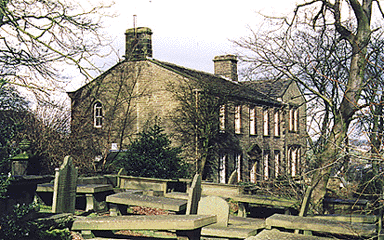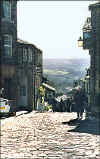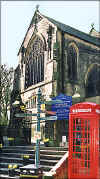
Haworth

Bronté Parsonage.
Haworth, pronounced Howarth, has understandably been described as Yorkshire’s Stratford-upon-Avon. Large numbers of visitors descend upon it, except perhaps in the dead of winter, coaches manoeuvre roads made for horse-drawn vehicles to get up and down the hills and parking is a test of endurance. Some come from nearby Keighley or Bradford for an afternoon out, others from Europe and America as part of their world heritage tour. The world and his wife are here. There are even signposts in Japanese. As always, a tourist industry has developed to supply Bronté teas, Bronté fudge, Bronté marmalade and Bronté fish and chips.
The main street is still cobbled and is likely to remain so now. It rises steeply from the valley where the Keighley and Worth Valley Railway still runs steam trains between the well-preserved Victorian stations. You’ve already seen it if you have seen the films the Railway Children and Yanks. Lining the main street of Haworth are cottages, pubs and, of course, shops before one gets to the church and its graveyard.
Main Street (Click)
The Bronté Parsonage is the main attraction. It was here that Emily lived unhappily with Charlotte, Anne, Branwell and their father, Patrick in the early nineteenth century. Here she wrote Wuthering Heights before her early death at the age of twenty-eight. The Parsonage is now a museum full of Bronté memorabilia, cared for by the Bronté Society.
Parish Church (Click)
But it is the bleak moors around Haworth which are most associated with the Brontés and Wuthering Heights. The ruined farmhouse Top Withens is said to be its inspiration. When the wind howls and the rain drives sideways this part of the West Riding is not the most hospitable place. The blackened gritstone walls of the fields and the subdued colours of the vegetation together with the cries of the birds all add to the atmosphere of isolation. At the same time it can be invigorating and uplifting. Get away from the tourists though.
If you really want to see an unspoilt Pennine hill-top village, Heptonstall is the place, across the moors to the south. Take the road through Oxenhope and you end up in frontier towns and villages like Hebden Bridge and Todmorden on the road to Lancashire.
The Pennines used to be a formidable physical barrier but today trains and the M62 enable one to get quickly across. On the M62 going west there is a sign of the red rose which marks one’s descent into Lancashire. Coming east at the top of Windy Hill at 1221 feet where the Pennine Way crosses the motorway is a welcoming white rose which signals the return to Yorkshire hospitality.
David Brearley.

